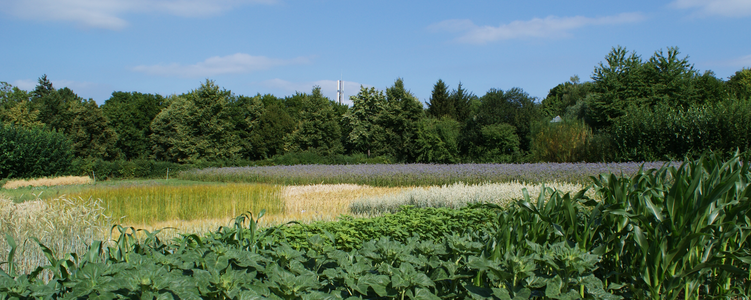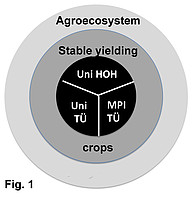Overall concept
Yield-stability in dynamic environments

Europe’s current agroecosystems combine a low biodiversity with high use of resources. To increase the biodiversity while also saving resources we need efficient crop plants with high yield-stability, which are provided by practical plant breeding. They build the basis for groceries and animal feedingstuff as well as new products within the bioeconomy. Since decades breeders focus on increasing plant yield. Stabilizing yield on a high level gains more importance due to climate change and corresponding increased weather dynamics with extreme events (heat and drought waves), decreasing resources and invasive pathogens. Additionally, despite a changing dynamic environment, consumers highly value sustainable production coupled with high quality of the products.
Today crops are grown in monocultures with great yield on our fields; however, these plants are genetically very homogeneous and contain only a fraction of the genetic variety of their wild ancestors through selection. There are cases in which genes and gene clusters important for biotic and abiotic stress resistance are lost during plant breeding. These genes could only partly be reestablished by marker-assisted breeding. It is uncertain whether future crop lines still contain the plasticity to persist in am increasingly more dynamic environment. Targeted cultivation management can increase yield-stability, but this is still limited by the genetic composition of the plant. Additionally, not all components influencing yield-stability in crops, as well as in whole agroecosystems, are clearly known. Likewise, the exact costs for the adaptive capacity (trade-offs) are unknown, as they vary according to region and plant culture.
Fundamental molecular research contributed during the last years to a conceptual understanding of the molecular networks, which enable resilience and adaptation strategies of the plants. So far this molecular-biological step was mainly limited to model plants and controlled conditions in greenhouses. Therefore, it is necessary to investigate if and to what extend these concepts can be applied during practical breeding of crop plants, as in the field, plants are exposed to multiple stresses. For example, drought and pathogens can have synergistic effects and tremendously lower yield. Yet, specific genotypes can get resistant against pathogens through drought and optimized nutrition management. In a variable environment, yield can only be influenced by the management to a certain extent.
In the regional research alliance, elite researchers of plant breeding and molecular plant research will work together to use mutual strategies and research approaches for developing yield stable plants (Fig.1). The aim is to use insights in the molecular, genetic networks and concepts based on the work with model plants for breeding. This approach exceeds the establishment of single beneficial features (genes) in lines by molecular markers. It is supposed to lead to a reevaluation of the molecular basics of yield-stability in actual cultivation systems. Additionally, it is intended to use genetic networks of crop plants in their interaction with their environment to gain yield-stable maize- and wheat varieties for sustainable cultivation. The molecular genetic basics of tolerance against abiotic and biotic stress, the importance of heritability in crossings, the basics of hybrid breeding, the manipulation of chromosome sets and the generation of double haploid genotypes are aspects, which will be considered in this association. These topics are, besides the genomic breed appreciation, outstandingly important for a new quantitative genetic breeding approach.

The yield-stable crop lines will allow additionally developing new products and concepts for the bioeconomy. It is expectable, that via the regional connection of research activities with the intersection of quantitative breeding methods, crop science and molecular plant research, a tremendous breeding success will be achieved which will contribute to the insurance of food- and resource-provision in a growing bioeconomy.
